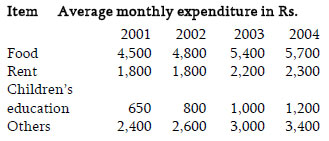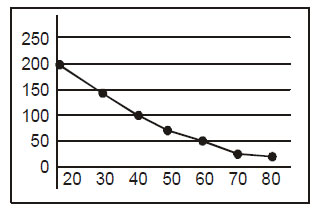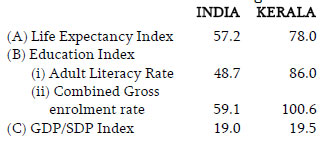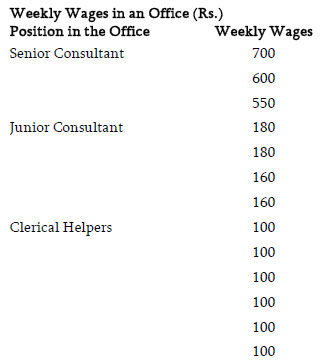(HOT) UPSC Current Affairs 2025 PDF
NEW! The Gist (NOV-2025) | E-BOOKS
(Exam Paper) UPSC IAS Mains 2004: General Studies
(Exam Paper) UPSC IAS Mains 2004: General Studies
Paper - I
1. Answer any one of the following (in about 250 words): 30
(a) Discuss the major regulations enacted by the British rulers to curb the
freedom of Press in India.
(b) Form a critical assessment of the Non- Cooperation Movement.
2. Answer any two of the following (in about 150 words each): 2 × 15 = 30
(a) What led to the partition of Bengal in 1905?
(b) Write a note on the Theosophical Society.
(c) Discuss the main findings of the Hartog Committee (1929).
3. Write about the following (not exceeding 20 words each): 15 × 2 = 30
(i) Upanishads
(ii) Vajrayana
(iii) Kumarsambhav
(iv) Razmnama
(v) Mirza Haidar
(vi) Muhammad Barkatullah
(vii) Sohan Singh Bhakna
(viii) Alluri Sitaramaraju
(ix) Canjeevaram Natrajan Annadurai
(x) Jadong
(xi) Jadunath Sarkar
(xii) Nazir Hasan
(xiii) Subhash Gupte
(xiv) Acharya Nirmalya
(xv) Jyotirao Phule
4. Answer any two of the following (in about 125 words each): 2 × 10 = 20
(a) Examine the distribution of oil refineries in India.
(b) Why are the Aravallis called a divide between Mewar and Marwar ?
(c) What is Golden Quadrilateral ? How will it help in the economic development
of the country ?
5. Write short notes on the following (in about 20 words each): 5 × 2 = 10
(a) El Nino, La Nina and monsoon rains
(b) The Sambhar lake
(c) The Sundarbans
(d) Bombay High
(e) Sabarkantha & Banaskantha
6. Answer any one of the following (in about 250 words): 30
(a) What is the significance of a preamble to a constitution ? Bring out the
philosophy of the Indian polity as enshrined in the Preamble of the Indian
Constitution.
(b) Discuss the meaning of “breakdown of constitutional machinery”. What are its
effects.
7. Answer any one of the following (in about 250 words) : 30
(a) Discuss how the Constitution of India provides equal rights.
(b) How does the Indian Constitution seek to maintain independence of the Public
Service Commission ?
8. Answer any two of the following (in about 150 words each): 2 × 15 = 30
(a) Define Money-bill. Discuss how it is passed in the Parliament.
(b) What is a Finance Commission ? Discuss the main functions of the State
Finance Commission.
(c) Discuss how state governments can exercise control over panchayats.
9. Answer the following (in about 20 words each): 5 × 2 = 10
(a) What is Habeas Corpus ?
(b) What are the constitutional restrictions imposed upon the power of borrowing
of the state governments ?
(c) What is the special facility provided to the linguistic minorities under
Article 350 A ?
(d) How can a judge of the Supreme Court be removed?
(e) How is the Election Commission of India constituted?
10. Write on any one of the following (in about 250 words): 30
(a) The Inter-State river water dispute has once again assumed centre-stage
after the Punjab Assembly’s Bill terminating all previous accords on river
waters. Discuss.
(b) What is PURA ? Discuss its major objectives.
11. Write on any two of the following (in about 125 words each): 2 × 10 = 20
(a) Explain UNDP Report on human development in India.
(b) What is WTO ? What are India’s objections to its overall functioning ?
(c) Discuss the utility of e-governance in the Indian context.
12. Write notes on any two of the following (in about 125 words each) : 2 × 10 = 20
(a) Housing for all by 2010 is the goal set by the National Habitat Policy.
How far is it achievable ?
(b) “Is greater spending on education linked to higher literacy ?”Discuss.
(c) What is Enterprise Resource Planning
13. Write about the following (in about 20 words each): 5 × 2 = 10
(a) ISRO
(b) Central Vigilance Commission
(c) NDDB
(d) Hiren Mukherjee
(e) Pareechu Lake
DOWNLOAD UPSC MAINS GS 10 Year PAPERS PDF
DOWNLOAD UPSC MAINS GS SOLVED PAPERS PDF
Buy Printed Study Kit for IAS Mains General Studies
Download E-Books for UPSC IAS Exams
Paper - II
1. Answer any TWO of the following (Answer to each question should be in about 150 words): 15 × 2 = 30
(a) Discuss the role played by the United States in promoting/hindering
improved relations between India and Pakistan.
(b) Explain India’s strategic relationship with Russia.
(c) Account for India’s increasing involvement in the SouthEast Asian region.
2. Answer the following (Answer to each question should be in about 20 words) : 2 × 5 = 10
(a) The Panchsheel Pact.
(b) India-Israel Cooperation.
(c) European Union’s trade restrictions against India.
(d) Weak-spots in India-Nepal relations.
(e) Hot Line between Islamabad and New Delhi.
3. Answer the following (Answer to each question should be in about 20 words) : 2 × 5 = 10
(a) Categorize the People of Indian Origin (PIO).
(b) Point out the difference between the JewishDiaspora and the Indian Diaspora.
(c) What are the references made to the NRI in the Union Budget July 2004 ?
(d) What is known as reverse migration ?
(e) Why was January 9 chosen to observe the NRI (Pravasi Bharatiya Diwas) Day?
4. Answer any ONE of the following (in about 250 words): 30
(a) State the comprehensive structural reforms undertaken to improve the
Indian economy since 1991.
(b) How is poverty level measured ? Evaluate poverty eradication programmes in
India.
5. Answer any TWO of the following (in about 150 words each): 15 × 2 = 30
(a) Describe the recommendations of Narasimham Committee regarding the
banking sector in India.
(b) Examine the effect of economic development on environmental degradation in
India.
(c) What ails India’s road transport economy ? Suggest measures of remedy.
6. Answer the following (in about 20 words each): 2 × 15 = 30
(a) What are the major provisions of Agreements on Agriculture in the context
of World Trade Organisation?
(b) Elucidate Special Drawing Rights.
(c) What is Cash Reserve Ratio ?
(d) What does “priority sector lending” mean?
(e) What is Minimum Alternative Tax (MAT)?
(f) What is Business Process Outsourcing (BPO)?
(g) What is ‘social justice’ in the context of Indian economy ?
(h) Explain the objectives of Plant Varieties Right Act, 2002.
(i) How is human development index for life expectancy measured ?
(j) What are the objectives of the Twelfth Finance Commission ?
(k) Explain the necessity and role of controls in a mixed economy like India.
(l) Distinguish between primary sector, secondary sector and tertiary sector.
What is the change in the share of each sector in Gross Domestic Product (GDP)
during period of 1950-2000?
(m) What is the main objective of Security and Exchange Board of India (SEBI) ?
(n) What has been the policy of agricultural development during last two decades
in India ?
(o) What is deficit financing ?
7. Answer any TWO of the following (Answer to each question should be in about 150 words): 15 × 2 = 30
(a) Discuss the role of ‘intelligence’ in the making of foreign policy.
(b) Describe the role of the Amnesty International in securing human rights.
(c) Examine the relevance of Pt. Jawaharlal Nehru’s ideas in the international
relations of today.
8. Answer the following (Answer to each question should be in about 20 words) : 2 × 5 = 10
(a) ICJ verdict on Israel’s erection of barrier on the West Bank.
(b) Beijing Taiwan Spat.
(c) Prospects of international water-wars.
(d) Al Gharib Prisoners.
(e) Recent developments in India- Myanmar relations.
9. Answer the following, by expanding and explaining the objectives (Answer to each question should be in about 20 words): 2 × 5 = 10
(a) BIMSTEC
(b) ARF
(c) Red Cross
(d) OPEC
(e) IAEA
10. Answer any ONE of the following (Answer should be in about 250 words):
(a) Discuss in detail “Alternative Energy Sources”: 30
(b) “Global Warming”- Discuss. 30
11. Answer any TWO of the following (Answer to each question should be in about 150 words): 15 × 2 = 30
(a) What is Super-conductivity’? Give its uses and applications.
(b) What is Biotechnology ? Discuss the important applications of Biotechnology.
(c) Describe the importance of “Laser” in war and peace.
12. Answer the following (in about 20 words each): 2 × 5 = 10
(a) What do you understand by E-governance ?
(b) What is a URL ?
(c) What do the following stand for ?
(i) CD-ROM (ii) USB
(iii) ITES
(iv) FORTRAN
(d) What do you understand by MP3 ?
(e) What are cyber crimes ? How are these protected?
13.
(a) The table below shows the average monthly house hold expenditure on different items for the years 2001 to 2004:

Represent the above information by suitable diagram. 8
(b) According to the Union Budget 2004-05, the total receipts of Rs. 4,77,829 crore can be approximately broken up as follows
A. Direct Taxes 25%
B. Indirect and other Taxes 32%
C. Non-tax Revenue Receipts 13%
D. Non-debt Capital Receipts 6%
E. Borrowings and other liabilities 24%
Represent the above by a Pie-diagram. 8
14.
(a)Read the given data and answer the questions that follow:

(i) At what speed (kmph) is the engine considered to have its normal length
of life?
(ii) The life of an engine driven at 20 kmph is how many times more than the
life of an engine driven at 40 km per hour ?
(iii) If an engine, usually driven at speed of 60 km per hour, had a lifespan of
30,000 kilometres, what will be the lifespan of an engine which is usually
driven at a speed of 40 km per hour?
(iv) Given that the normal lifespan of an engine is 60,000 km, what was the
lifespan of an engine, which was driven for 20,000 kilometres at a speed of 60
km per hour and later at a speed of 40 km per hour?
(v) Running an engine between 60 kilometres per hour and 40 km per hour, the
lifespan increases by what percent ?
(vi) At what speed (kmph) would the engine have the maximum life? 8
(b) The Human Development Index (HDI) is a simple average of three indexes
(A) Life Expectancy Index (to reflect health)
(B) Education Index (to reflect knowledge)
(C) GDP/SDP Index (to reflect standard of living)
The Education Index (B) is a combined index of two indexes :
(i) adult literacy rate with 2/3 weight and
(ii) combined gross enrolment rate with 1/3 weight. Compute the HDI for INDIA
and KERALA from the following data:

15. Attempt all the questions. All questions carry equal marks: 4 × 2 = 8
(a) Consider the following data

Which of the three averages — arithmetic mean, median and mode, adequately represents the data ?
(b) In a moderately skewed distribution the following values were obtained
Arithmetic mean = 24.6 Mode = 26.1 Find the value of the median and explain the
reason for the method
employed.
(c) Suppose an item is sold at the rates of 18, 20, 22 and 25 rupees per litre
in four different months. Assuming that equal amounts of money are spent on the
particular item by a customer in the four months, find the average price in
rupees per litre of the item.
(d) The average of 11 observations is 50. The mean of the first six observations is 49 and that of the last six observations is 52. Find the value of the sixth observation.



